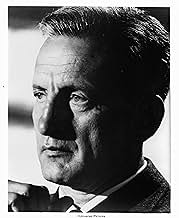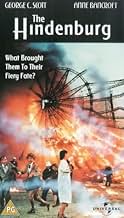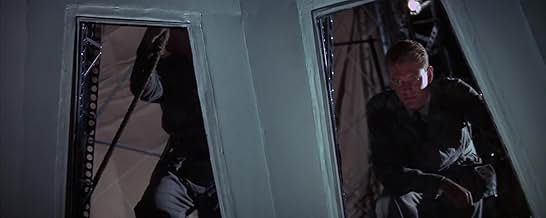CALIFICACIÓN DE IMDb
6.3/10
7 k
TU CALIFICACIÓN
Crónica de la catástrofe del Hindenburg, en la que un zepelín estalló en llamas.Crónica de la catástrofe del Hindenburg, en la que un zepelín estalló en llamas.Crónica de la catástrofe del Hindenburg, en la que un zepelín estalló en llamas.
- Dirección
- Guionistas
- Elenco
- Nominado a 3 premios Óscar
- 2 premios ganados y 4 nominaciones en total
Richard Dysart
- Lehmann
- (as Richard A. Dysart)
Opiniones destacadas
If a film about The Hindenburg had to be made it certainly would have been made in the decade of the disaster film, the Seventies. But this film labored under a unique handicap that none of the other disaster films of the decade had.
Unlike the sinking of the Titanic or the blowing up of Mount Krakatoa and certainly not like any of the potential but fictional disaster events that were film subjects, The Hindenburg was recorded on sight with newsreel cameras and on radio with Herbert Morrison's never to be forgotten broadcast. A lot of people now still remember it, let alone back in 1975.
What Robert Wise did and maybe more successfully than any other director was make full use of the famous newsreel footage and carefully edited it into his film, with slow motion techniques into the personal attempts by the cast to try and escape the holocaust. The Hindenburg received Oscar nominations for sound, cinematography, and art&set design with a special award for special effects. Yet no nomination for editing which the main plus this film has going for it.
Of course we don't know what ever really happened to the Hindenburg and the film takes account of all the theories put forth. It also uses the real names of the people who were passengers, crew, and officials of the Third Reich. The Nazi government had a big stake in the dirigible fleet they had built, they were as much propaganda value for them as Max Schmeling in boxing and Gottfried Von Cramm in tennis.
Of course had they had access to helium to float the big guys this might never have happened. But the USA had a near total monopoly on the world's helium and was not selling it to Hitler. Hence they used the lighter, but flammable hydrogen with the result of the tragedy.
George C. Scott and Anne Bancroft head the cast as a Luftwaffe official and a worldly old world countess traveling to the USA to visit her deaf mute daughter going to school for same in Boston. The Nazis didn't believe in helping those they considered defectives, another lovable quality about them.
The Hindenburg is a sobering and near factual account of what happened in Lakehurst, New Jersey that afternoon. It's one of the best of the Seventies disaster films and should not be missed.
Unlike the sinking of the Titanic or the blowing up of Mount Krakatoa and certainly not like any of the potential but fictional disaster events that were film subjects, The Hindenburg was recorded on sight with newsreel cameras and on radio with Herbert Morrison's never to be forgotten broadcast. A lot of people now still remember it, let alone back in 1975.
What Robert Wise did and maybe more successfully than any other director was make full use of the famous newsreel footage and carefully edited it into his film, with slow motion techniques into the personal attempts by the cast to try and escape the holocaust. The Hindenburg received Oscar nominations for sound, cinematography, and art&set design with a special award for special effects. Yet no nomination for editing which the main plus this film has going for it.
Of course we don't know what ever really happened to the Hindenburg and the film takes account of all the theories put forth. It also uses the real names of the people who were passengers, crew, and officials of the Third Reich. The Nazi government had a big stake in the dirigible fleet they had built, they were as much propaganda value for them as Max Schmeling in boxing and Gottfried Von Cramm in tennis.
Of course had they had access to helium to float the big guys this might never have happened. But the USA had a near total monopoly on the world's helium and was not selling it to Hitler. Hence they used the lighter, but flammable hydrogen with the result of the tragedy.
George C. Scott and Anne Bancroft head the cast as a Luftwaffe official and a worldly old world countess traveling to the USA to visit her deaf mute daughter going to school for same in Boston. The Nazis didn't believe in helping those they considered defectives, another lovable quality about them.
The Hindenburg is a sobering and near factual account of what happened in Lakehurst, New Jersey that afternoon. It's one of the best of the Seventies disaster films and should not be missed.
I actually thought the crash sequence in "The Hindenburg" looked pretty realistic. The combination of newsreel footage and special effects was effective as it was often difficult to distinguish between the two.
Robert Wise was an editor on "Citizen Kane" and he skillfully combined studio shots with stock footage on that great film as well. What worked on both of these movies was that the new shots were matched with the archival footage in terms of quality. Scratches, shaky camera movements and other imperfections were added to the special effects sequences to blend better with the existing newsreels.
Sure the script has some flaws but let's face it, you watch a film like this to see the disaster and "The Hindenburg" delivers.
Robert Wise was an editor on "Citizen Kane" and he skillfully combined studio shots with stock footage on that great film as well. What worked on both of these movies was that the new shots were matched with the archival footage in terms of quality. Scratches, shaky camera movements and other imperfections were added to the special effects sequences to blend better with the existing newsreels.
Sure the script has some flaws but let's face it, you watch a film like this to see the disaster and "The Hindenburg" delivers.
This is very much a niche film--one that will appeal to some viewers but probably not most. I was attracted to it for two reasons--my love of George C. Scott films as well as because I am a huge airship lover and have always wondered what it would have been like to ride in one of these behemoths. However, given that most people DON'T have this fantasy and Scott is quickly becoming a forgotten name in films, I honestly can't see most people seeing or enjoying the film.
The film is a fictionalized account of the final voyage of the Hindenburg. While it is all supposition and guesswork, it is pretty exciting. Plus at the end of the film they did a nice job of integrating existing newsreel footage into the body of the movie. The acting is pretty good and the special effects excellent, but much of the spectacle is lost on television--it was amazing on the big screen.
Overall, history lovers will be happy but most others who have no idea about this event or its context will probably be left bored and confused.
The film is a fictionalized account of the final voyage of the Hindenburg. While it is all supposition and guesswork, it is pretty exciting. Plus at the end of the film they did a nice job of integrating existing newsreel footage into the body of the movie. The acting is pretty good and the special effects excellent, but much of the spectacle is lost on television--it was amazing on the big screen.
Overall, history lovers will be happy but most others who have no idea about this event or its context will probably be left bored and confused.
On the 6th of May 1937 The Hindenburg Zeppelin, whilst attempting to dock at Lakehurst Naval Air Station, New Jersey, burst in to flames. Thirty Six people were killed that fateful day, this is a fictionalised account of what may have happened that day.
There are quite a few theories as to what caused the Hindenburg disaster, this film takes the sabotage angle and thankfully (to me) it makes for a very engrossing picture full of tension, drama and no little horror. The 70s was a time for disaster pictures, it seemed that one was churned out every year, not all were great movies for sure, but some actually were viable entertainment, and with The Hindenburg we get good old fashioned story telling, character build up and the pay off actually, well, pays off!
Running at just over two hours long, first time viewers should be aware that for a good 100 minutes of the film it's all about the set up, there are characters to meet and journey motives to explore, all passengers are under suspicion, and we live thru this courtesy of George C Scott's (wonderful here as usual), Col. Franz Ritter, the man assigned to ensure no sabotage can take away the pride of Germany. The film has flaws for sure, the array of passengers are the usual disaster picture assortment of beings, and of course some situations beggar belief, but this is a disaster flick after all, and director Robert Wise pulls it all together nicely for the films finale, and what a finale it is. Using stop frames, and inter cutting film of the actual disaster itself, the finale grips with a sense of realism, the plot line may well be merely one of the reasons put forward, but the crash is indeed a thing of fact, and it closes the film in a very sombre and impacting way. 7/10
There are quite a few theories as to what caused the Hindenburg disaster, this film takes the sabotage angle and thankfully (to me) it makes for a very engrossing picture full of tension, drama and no little horror. The 70s was a time for disaster pictures, it seemed that one was churned out every year, not all were great movies for sure, but some actually were viable entertainment, and with The Hindenburg we get good old fashioned story telling, character build up and the pay off actually, well, pays off!
Running at just over two hours long, first time viewers should be aware that for a good 100 minutes of the film it's all about the set up, there are characters to meet and journey motives to explore, all passengers are under suspicion, and we live thru this courtesy of George C Scott's (wonderful here as usual), Col. Franz Ritter, the man assigned to ensure no sabotage can take away the pride of Germany. The film has flaws for sure, the array of passengers are the usual disaster picture assortment of beings, and of course some situations beggar belief, but this is a disaster flick after all, and director Robert Wise pulls it all together nicely for the films finale, and what a finale it is. Using stop frames, and inter cutting film of the actual disaster itself, the finale grips with a sense of realism, the plot line may well be merely one of the reasons put forward, but the crash is indeed a thing of fact, and it closes the film in a very sombre and impacting way. 7/10
Even the presence of someone like GEORGE C. SCOTT can't save THE HINDENBERG from being a less than extraordinary recreation of the famous tragedy at Lakehurst, N.J. when the German dirigible fueled by hydrogen caught fire during its landing during a lightning storm.
The most compelling footage comes toward the end of the film, when the craft is about to land and we know the unthinkable is about to happen. The special effects (designed by Alfred Whitlock) are especially strong here and combined with actual black and white footage of the event, it is mind boggling to watch. Ironically, the craft was so close to landing, with men on the ground already holding onto the landing ropes to secure the craft for its safe approach.
Unfortunately, the script Robert Wise directs is sub-par as far as interest in the characters. I'd be tempted to call it "Grand Hotel in the Sky" but there's not even enough soap-opera element to the cast of passengers that make any of them memorable, including ANNE BANCROFT, as a Countess, GIG YOUNG and BURGESS MEREDITH.
The plot is mostly fiction about a crew member causing a bomb to explode and ignite the huge aircraft, not really substantiated by the known facts although it makes for a compelling story. Historically correct or not, it's a film worth seeing but don't expect a disaster film comparable to THE TOWERING INFERNO or TITANIC.
What's really fascinating is seeing what the inside of the dirigible is like for passenger travel, truly elegant and comfortable...a reminder of the sort of elegance that greeted those aboard the TITANIC.
The most compelling footage comes toward the end of the film, when the craft is about to land and we know the unthinkable is about to happen. The special effects (designed by Alfred Whitlock) are especially strong here and combined with actual black and white footage of the event, it is mind boggling to watch. Ironically, the craft was so close to landing, with men on the ground already holding onto the landing ropes to secure the craft for its safe approach.
Unfortunately, the script Robert Wise directs is sub-par as far as interest in the characters. I'd be tempted to call it "Grand Hotel in the Sky" but there's not even enough soap-opera element to the cast of passengers that make any of them memorable, including ANNE BANCROFT, as a Countess, GIG YOUNG and BURGESS MEREDITH.
The plot is mostly fiction about a crew member causing a bomb to explode and ignite the huge aircraft, not really substantiated by the known facts although it makes for a compelling story. Historically correct or not, it's a film worth seeing but don't expect a disaster film comparable to THE TOWERING INFERNO or TITANIC.
What's really fascinating is seeing what the inside of the dirigible is like for passenger travel, truly elegant and comfortable...a reminder of the sort of elegance that greeted those aboard the TITANIC.
¿Sabías que…?
- TriviaThe actual site of the Hindenburg crash, at Lakehurst Naval Air Station (now part of Joint Base Lakehurst-Dix-McGuire) is marked with a chain-outlined pad and bronze plaque where the airship's gondola landed. It was dedicated on May 6, 1987, the 50th anniversary of the disaster. Hangar #1, which still stands, is where the airship was to be housed after landing. It was designated a National Historic Landmark in 1968.
- ErroresThe incident depicting the Hindenburg's crew repairing the tear in the Zeppelin's cover as it drifts lower and lower over the Atlantic is factual; however, the event occurred on the Graf Zeppelin, not the Hindenburg.
- Citas
Mrs. Channing: Sugar, next time, let's take the Titanic.
- Créditos curiososThe film opens with the 1936 Universal logo followed by a newsreel prior to the credits.
- Versiones alternativasDeleted scenes were added back into the film for television airings, including one in which Goebbels shows Ritter a display of items used in attempted anti-Nazi attacks, including a bomb found on board the ocean liner "Bremen".
- ConexionesEdited into Los cazadores del arca perdida (1981)
- Bandas sonorasThere's a Lot To Be Said for the Fuehrer
Music by David Shire
Lyric by Ed Kleban (as Edward Kleban)
Performed by Peter Donat (uncredited), Robert Clary (uncredited)
Selecciones populares
Inicia sesión para calificar y agrega a la lista de videos para obtener recomendaciones personalizadas
- How long is The Hindenburg?Con tecnología de Alexa
Detalles
- Fecha de lanzamiento
- País de origen
- Idioma
- También se conoce como
- The Hindenburg
- Locaciones de filmación
- Marine Corps Air Station Tustin, Tustin, California, Estados Unidos(used for Naval Air Station Lakehurst - airship hangers still standing in 2022)
- Productora
- Ver más créditos de la compañía en IMDbPro
Taquilla
- Presupuesto
- USD 15,000,000 (estimado)
- Tiempo de ejecución
- 2h 5min(125 min)
- Color
- Relación de aspecto
- 2.35 : 1
Contribuir a esta página
Sugiere una edición o agrega el contenido que falta





































